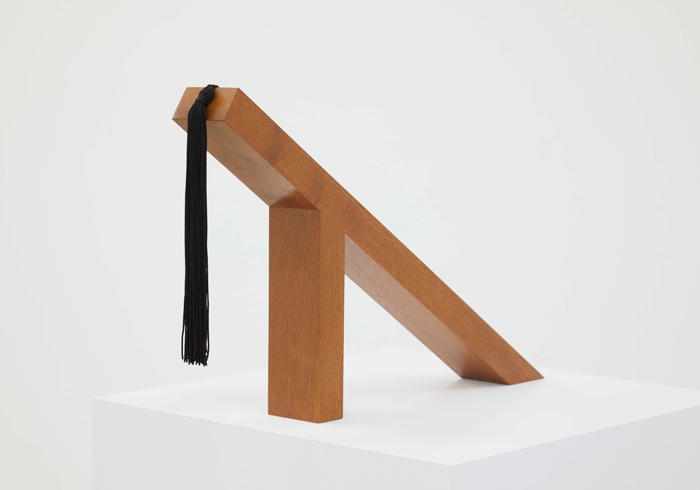A bittersweet melancholy sound, like the horn of a ship evoking both loss and new beginnings, intermittently resonates throughout the gallery spaces. This sound piece, Material for a sculpture acting as a testament to both a nation’s pioneering development and continuing decline (2011), is one of ten works in the Material series (2010–12), each accompanied by their titles vinyl-printed on the wall. All but two are displayed on white plinths, and their titles describe, but do not identify, commemorated figures or events. The absence of specific information makes way for multiple associative possibilities. A black tassel in Material for a sculpture recalling destruction of a prominent public monument in the name of national resistance (2010), for instance, suggests a fez: an item of headwear with a complex wealth of cultural, political and symbolic history. For me, I confess, with my unworldly English upbringing, the fez conjures, before all, the British comedian and deliberate bungler of magic Tommy Cooper.
Each of the works in the Material series is inspired by public monuments well known to the artist but not identified. While referencing the monumental, however, the scale is decidedly human. Material for a sculpture commemorating an economist whose name now marks the streets and squares he once frequented (2011) suggests a redress. Personal effects – items worn or held close to the body – are arranged in a vitrine. Missing, however, is personalisation. Where an engraved or embroidered name or monogram might be expected – on the case of a fob watch or the corner of a handkerchief – one finds a conspicuous blank suggesting, perhaps, that a frequently used public name might lose its intimate identity. The removal of names has sinister connotations, invoking refusals of humanity and erasures from history. An absence of a name, particularly one rendered invisible by overfamiliarity, may permit certain liberties.
Three copies of Book of Facts: A Proposition (2017) are presented at individual desks, each with a white plinth-seat – positioning the reader as an active element of the work. The book is a catalogue of an exhibition that never was, replete with plates, bibliography, a list of illustrations and index, but missing figurative images. Titles in the bibliography are without authors and often end in ellipses (A History of Mythology in … for example). The plates are simple diagrams, each a rectangular outline framing captioned red dots that mark the position of objects in the ‘picture’. The accompanying texts, drawn from a diverse range of research, allow the reader to build an image in their imagination without permanently fixing it. Despite – or rather because of – its absences, the book proffers myriad permutational imagery and reading. Omission, here, does not equal reduction. It is employed, instead, as a device of democratic enrichment, recalling Barthes’s ‘birth of the reader’: ‘A text consists of multiple writings, issuing from several cultures and entering into dialogue with each other’, writes Barthes in The Death of the Author (1967).
Barthes resonates as I encounter Common Elements (2013). Framed fragments of text from the autobiographies of four public figures, and photographs of recreated museum pieces, the origins of which range from the scholarly to the domestic, line the four walls. Five sculptures referring to forms seen by the artist in museums – one resembles a sepulchre – occupy the floorspace. Decontextualised and reconfigured in a new relation to one another, these elements mingle into narratives resembling memory. Names of the autobiographers are, on this occasion, given – but very quietly, in a small wall plaque: among them, cultural theorist Edward Said. As I read one of the texts – ‘What does a magician do? Doesn’t he give himself the ability to foresee the future?’– I think perhaps my Tommy Cooper reference is not so ridiculous. My childhood memory of Cooper and his inappropriately appropriated fez connects me, however tenuously, to a pool of memories, prosaic and profound, beyond my personal experience but not beyond the magic of imagination. Linda Taylor
Iman Issa: Materials for 2018 at Spike Island, Bristol, 17 February – 15 April 2018
From the April 2018 issue of ArtReview
